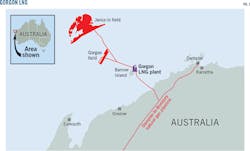Delays, supply overhang menace North American LNG exports
James F. Bowe, Jr.
King & Spaulding
Washington
Permitting problems and delays affecting North American LNG export projects could combine with an overhang of LNG supply to make it difficult for North American LNG projects that have not yet taken final investment decision (FID) to get to FID over the next several years. LNG export projects coming on line in Australia, plus promising projects in Africa, could also soak up a good bit of whatever growth in LNG demand occurs, perhaps further delaying market commitment to new North American projects.
Supply, demand
LNG supply appears at least temporarily to have outstripped demand. Four new export liquefaction trains started operations last year-at ExxonMobil PNG Ltd.'s PNG LNG, BG Group's Queensland Curtis LNG, Santos Gladstone LNG, and Sonatrach's Arzew LNG-adding more than 16 million tonnes/year (tpy) to supplies. Another four land-based terminals and one or two floating LNG (FLNG) plants are likely to come on line this year, putting an additional 21 million tpy into the market.
LNG production expected this year includes:
• Chevron Australia Gorgon LNG (Fig. 1)
• ConocoPhillips Australia Pacific LNG
• PT Donggi Senoro LNG
• Cheniere Energy Inc. Sabine Pass LNG
• Pacific Rubiales Energy FLNG
• Petronas FLNG 1
But 2014 LNG deliveries were roughly flat to 2011, and it is not clear demand will grow in 2015. Operators plan to commission 12 new regasification terminals this year, including some in new LNG importing markets such as Egypt, Jordan, Pakistan, Philippines, Poland, and Uruguay. At the same time, however, global export capacity will hit roughly 400 million tpy by 2018, as compared with 290 million tpy in 2013.
Three export projects reached FID last year-Freeport LNG, Sempra Energy's Cameron LNG, and Petronas Rotan FLNG 2-with Dominion Cove Point LNG beginning construction. Cheniere's Corpus Christi LNG will follow suit this year, with a possibility of Pacific NorthWest LNG (Petronas, Sinopec, Japex, Indian Oil Corp., and Petroleum Brunei) also reaching FID.
With crude oil prices down roughly 50% from 1 year ago, supply up slightly, and demand more or less flat, LNG prices have collapsed. In February 2015 the Platts Japan-Korea Marker (JKM) dropped to $6.73/MMbtu, down 65% from the record high of $20.20 set in February 2014.1 During February 2015 the JKM traded at a discount to the UK National Balancing Point natural gas trading hub.
Excelerate Energy has halted development of its proposed FLNG project in Lavaca Bay, Tex., and seems unlikely to revive it. Other export projects, including most of those in Canada, are also on uncertain footing. The prospects of a surge in LNG supplies from Australia and Africa-such as Anadarko Petroleum's Mozambique LNG project-are likely to push most other export project development horizons out and has created a buyer's market.
All US LNG export projects that have taken FID so far are brownfield projects with significant development cost advantages. Sabine Pass and Freeport are both working on their third trains, with Cameron applying itself to Trains 4 and 5. Both Cheniere Corpus Christi and Petronas Pacific NorthWest (Fig. 2) remain on track to make FID this year and several recently proposed small- to mid-scale projects are also proceeding. Cheniere has signed binding sale-and-purchase agreements for Trains 1 and 2 at Corpus Christi, the first greenfield US export project to be approved.
Whether an export project moves forward depends on availability of development funding to survive a long and costly permitting phase, long-term customer commitments to support this funding, and perseverance to complete the increasingly complex (at least in the US) permitting process.
Lower oil prices
Assuming that a project's sponsors and potential counterparties remain interested in an LNG export project, the drop in oil prices could benefit projects under development by lowering construction costs. Reduced competition for skilled labor and raw materials given the slowdown in oil and gas drilling may already be helping LNG project developers. Woodside Petroleum, which in December postponed its decision to proceed with its Browse LNG project, noted that it had started seeing positive effects from lower oil prices on its supply costs and hoped to use the postponement as an opportunity to lower construction costs.
Any reduction in construction costs would be of particular benefit to Canadian export projects facing high costs stemming from the distance between the resource base and liquefaction plant and the lack of already developed infrastructure bridging this gap. Such effects, however, would vary based on prevailing local conditions.
LNG contracting
With the recent boom in US shale gas production and resulting rush to develop US LNG export projects, many would-be buyers sought Henry Hub indexed pricing as an alternative to traditional oil-linked prices. Some buyers have done this to help them renegotiate price terms under existing contracts, others to combine with current crude-related pricing in a hybrid pricing formula.
Whether LNG buyers will be able to take advantage of current market conditions to achieve lower prices in 2015 depends largely on the actual price review provisions in their contracts; e.g., whether prices will be redetermined by an arbitration panel based on pre-agreed criteria or whether no pricing changes are allowed without agreement of the parties.
The substantial downturn in Brent prices earlier this year allowed oil-linked LNG pricing to close much of the gap that once existed relative to Henry Hub pricing. Buyers, however, have not been content to simply get lower prices and diversified pricing mechanisms, they've also pursued supply diversification and destination flexibility. The latter of these trends is likely to continue, albeit at increased cost. Contracts may also move toward smaller contract quantities and shorter terms.
North American LNG export projects have some advantages. The tolling structure, under which buyers pay a fee for the option to take LNG but assume no obligation to take it, provides an attractive alternative for buyers seeking supply diversification. North American LNG contracts also do not include destination restrictions beyond those required by law. Infrastructure developed to support what were once LNG import operations can be adapted at low incremental cost to support LNG exports instead.
But North American projects also face some significant disadvantages. The drop in Brent pricing has removed some of Henry Hub prices' luster. Projects being developed in the northeast US, Atlantic Canada, the Pacific Northwest, and British Columbia-and ultimately these projects' customers-also have to bear the costs of developing substantial new pipelines and navigating the US permitting maze for both the export project and any pipeline.
Under Section 3 of the Natural Gas Act, the US Federal Energy Regulatory Commission (FERC) authorizes the siting and construction of plants used for natural gas exports, while the US Department of Energy's (DOE) Office of Fossil Energy authorizes exports of the commodity itself. FERC's environmental, design, and safety reviews of LNG export projects are far reaching and completing them costs several million dollars. The process is also time consuming, taking a minimum of roughly 450 days but sometimes stretching to 3 years or more. DOE is obligated to approve exports to nations with which the US has free-trade agreement (FTA). Most LNG markets, however, are in non-FTA nations.
As to exports to non-FTA nations, DOE determines whether the proposed export will "not be consistent with the public intereset;" presuming that it is, and imposing on opponents the burden to show that a particular proposal is not. DOE last year revised its permitting procedure and now only reviews an LNG export project after its environmental review has been completed (OGJ Online, Aug. 15, 2014).
The Canadian process for approving LNG export plants is much quicker and must less costly than the US processes. Many proposed LNG plants have already received Canadian National Energy Board and provincial approvals; more are seeking them. But Canadian export projects that will look to US gas sources will find themselves caught up in the US regulatory process.
DOE appears to take the position that an export to Canada (an FTA nation) must be reviewed and approved through the process applicable to non-FTA exports if the Canadian project proposes to export to non-FTA nations. And FERC must separately review and approve US gas pipeline expansions that are required to move gas into Canada for export.
Pricing changes
Hybrid pricing and increasingly complex pricing structures have resulted from the buyers' push to increase supply diversity. Some buyers are now seeking collaborations with other buyers to strengthen negotiating power. The February announcement of a joint venture between Tokyo Electric Power Co. (TEPCO) and Chubu Electric Power Co. is an example of this and will result in a single buyer for 16% of global LNG demand.
Price review provisions have also become more detailed and have taken on a larger role in negotiations, addressing greater interest on the part of both buyers and sellers to be able to reset prices periodically given the volatility of the past 10 years.
LNG demand
Demand forecasts for traditional Asian LNG markets (e.g., Japan and Korea) are less optimistic than they have been in the recent past. China and India have been active LNG buyers in the past few years, but their appetites now appear limited relative to what was expected just 1-2 years ago.
Europe has been the destination of last resort for spot cargoes. Economic recovery there remains slow, at best. It now appears unlikely that Europe's appetite for LNG will approach the peak seen in 2011 until late in the decade.
New markets are emerging, however, as new countries develop LNG import terminals for the first time. Uruguay, Poland, Jordan, and the Philippines all have their first LNG import terminals under construction. Development of floating storage and regasification units (FSRUs) may open up additional markets. At least 16 floating import terminals are now in use, with countries of operation including Argentina, Brazil, China, Dubai, Indonesia, Israel, Italy, Lithuania, Kuwait, and Malaysia.
Hawaii is seeking to become a bulk LNG importer. Guam may follow. And several Caribbean nations are trying to bring in LNG. These are small markets, but given current conditions, may be attractive to developers anyway. Risks of developing these markets include the lack of a demonstrated track record of reliably taking and paying for LNG, creditworthiness, and complicated scheduling if multiple customers will be drawing natural gas from the same terminal.
References
1. Platts Gas Daily, Mar. 16, 2015.
The author


